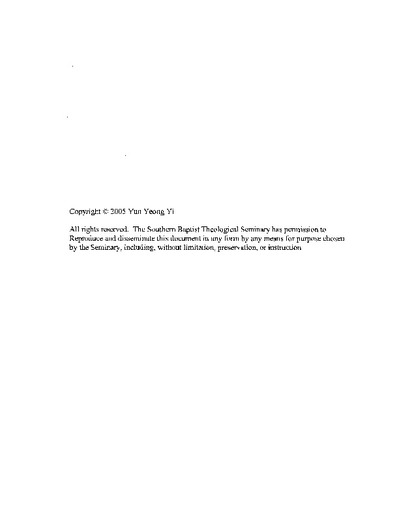| dc.contributor.advisor | Gentry, Peter J. | |
| dc.contributor.author | Yi, Yun Yeong | |
| dc.date.accessioned | 2009-12-10T21:01:38Z | |
| dc.date.available | 2009-12-10T21:01:38Z | |
| dc.date.created | 2005-05-05 | |
| dc.date.issued | 2005-05-05 | |
| dc.identifier.other | THESES Ph.D. .Y5t | |
| dc.identifier.uri | http://hdl.handle.net/10392/386 | |
| dc.description.abstract | This dissertation investigates the translation technique of the Greek Ecclesiastes and proposes the place of the Translator in the history of the transmission of the Greek text. Chapter 1 defines a text of the Greek Ecclesiastes. Since a Göttingen critical edition of the Greek Ecclesiastes has not been completed yet, Rahlfs' text is adapted as the basis for the analysis.
Chapter 2 compares and analyzes the Hebrew text of Ecclesiastes and its Greek translation on syntactical and lexical levels. The result of the study reveals that the Translator is not mechanical but is sensitive to context and to the demands of the target language although his translation is labeled as literal.
Chapter 3 deals with the issue of the identity of the Translator. A comparison with the translation techniques of Aquila, Theodotion, Symmachus, and the Kaige tradition betrays that the Translator is none of these. His translation is influenced by them in part but also contains his own distinctive patterns.
Finally, chapter 4 concludes that the Translator has most affinity to Theodotion and least affinity to Aquila. A distinctive Symmachian approach suggests the date of the translation as late as the second century. | en_US |
| dc.language.iso | en_US | en_US |
| dc.subject | Bible.--O.T.--Ecclesiastes--Translating. | en_US |
| dc.subject | Bible.--O.T.--Ecclesiastes | en_US |
| dc.title | Translation technique of the Greek Ecclesiastes | en_US |
| dc.type | Thesis | en_US |
| dc.publisher.institution | Southern Baptist Theological Seminary | en_US |

